
Vehicle(int _tires, int_year, int _hp, int _topSpeed, string _model) A class with a constructor looks like this: Fortunately, classes have these things called “constructors”, which can be used to initialize a new object of the class with the variables you want. Typing all of that stuff out is redundant and time-consuming. SUV.topSpeed = 120 //SUV has 120 topSpeed

You can then access the “members” of that object like this: Once you have the class created, you can create a new object of this class like this:
Unity tutorials code#
Move(Vector3.forward * hp) //not real code In C#, you would create a class like this: Each language that implements classes has its own syntax for declaring and using classes. In this post, I will be using C# since it is my preferred language in Unity. I highly recommend reading into them further if you’re interested in programming. Classes are a cornerstone of modern day programming languages and game development. I want to stress the point that my explanation of classes is incredibly primitive. There’s a seemingly endless number of unique enemies you could create using this class. At the end of the day, all of these enemies, even though they have unique values, are still an object of the “Enemy” type. Maybe you want another enemy that is incredibly fast with low damage, low armor, and moderate hit points. You may want an enemy with high hp and high damage but low armor? Not a problem. Any enemy you create can have these variables custom tailored to your liking. You could make an “Enemy” class that would contain variables like hitpoints, damage, armor, speed, Attack(), Defend(), and Move(). Beyond these basic variables I have discussed, we could take it further and say that each vehicle has a Mesh and MeshRenderer variable, which would allow us to give each vehicle a unique 3D model with unique textures.Īnother good example of classes would be creating enemies in a game. We could create separate values for each object and wind up with two very different objects in our game. Why Classes are Useful in Programming UnityĬonsider if we had a game where we had a Vehicle class and we create a motorcycle and an SUV object, which are both “Vehicles”. To try and explain this concept graphically, here’s my poor attempt at an information tree (Disclaimer: I know almost nothing about cars): In our program, we could have an Accelerate() function for each vehicle. A vehicle also has the ability to accelerate, for instance.


Additionally, classes are not limited to just variables. In programming, classes provide an easy way to create objects that all have the same components but unique values for those components. Additionally, every vehicle has a top speed and a horsepower that their engines produce. Even though the SUV, trailer-truck, and motorcycle all have different model names and years of production, they still have both of these components. Likewise, just about every vehicle has a model name and a year of production. So, even though each vehicle may have a different number of wheels, we can define them as all having some number of wheels. However, an SUV has 4 wheels, a trailer-truck has 18 wheels, and a motorcycle (usually) has 2 wheels. For instance, an SUV, a trailer-truck, and a motorcycle all have wheels. Conceptually, we can define any vehicle to have specific components that we would expect them to have. In the real world, we can put just about every kind of car, motorcycle, or truck into a category called “vehicle”. What is a Class?Ĭars are often used as a metaphor to explain what a class is. Today, I will remedy this problem with a quick introduction to classes in Unity. Yet, I have not yet written one about one of the fundamentals of object-oriented programming classes. I’ve written a lot of Unity 3D blog posts.


 0 kommentar(er)
0 kommentar(er)
